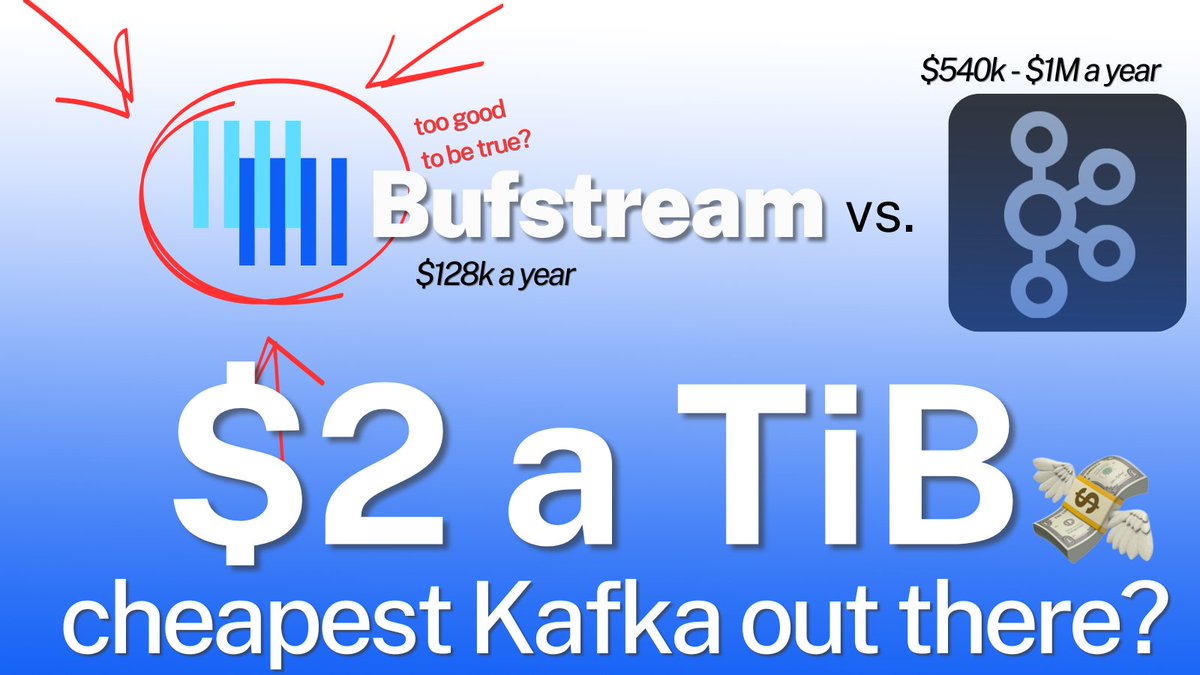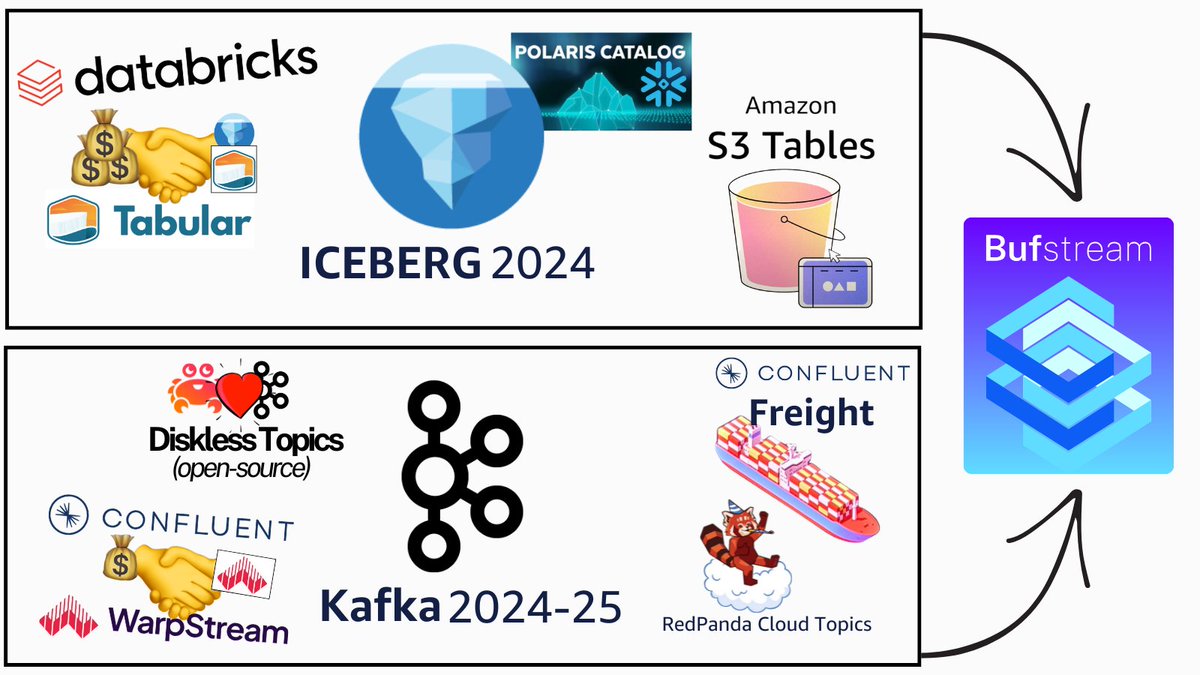A Kafka in the cloud doing 30MB/s costs more than $110,000 a year.
A $1,000 laptop can do 10x that.
Where did we go wrong? 👇
The Cloud. Namely - its absurd networking charges 👎
Let’s break it down simply:
• AWS charges you $0.01/GB for data crossing AZs (but in the same region).
• They charge you on each GB in and out. Meaning each time a GB passes, you pay twice - for the one who sends it (outgoing) and the one who receives it (incoming)
• For a normal Kafka cluster with replication factor of 3 and a read fanout of 3x, you are going to be charged:
• 2x for 2/3rd of the produce throughput
• 4x for 100% of the produce from replicating it
• 6x of 2/3rd of the produce throughput for consumption.
(but it can get a lot worse - read until the end to see)
Simple example:
• 3-broker cluster, each in a separate AZ
• 3 producers, each in a separate AZ
• 3 consumer groups with 3 consumers each, each group with consumers in a separate AZ
The producers are producing 30MB/s in total to the same leader.
2/3 producers are in a different AZ, so 20MB/s of produce traffic is being charged at cross-zone rates. 👌
It’s charged both on the OUT (producer’s side) and IN (broker’s side).
The leader is replicating the full 30MB/s to both of its replicas.
This is again being charged both on the OUT (leader’s side) and IN (follower’s side), for both replication links. (60MB/s)
Then, each of the 3 consumer groups has 3 consumers.
All consumers read from the leader, with 2/3 in a different zone.
This results in 20MB/s of consume traffic charged at cross-zone rates PER GROUP. (60MB/s total)
Again charged both on the OUT (broker’s side) and IN (consumer’s side).
The total amounts to 140MB/s worth of cross-AZ traffic. Charged both ways.
When one MB is $0.00001/s, this means we’re paying $0.0028/s. 🤔
That’s:
• $241 a day 😕
• $7500 a month 😥
• $88,300 a year 🤯
It all goes down the drain on network traffic ALONE. 🔥
What about the hardware?
Quick napkin math assuming:
• 7 day retention
• all of the data is on EBS (not using tiered storage since it's not GA yet)
• keeping 50% of the disk free for operational purpose (don't ask me what happens if we run out of disk)
• the 3 brokers are running modest r4.xlarge instances (kinda overkill but hey, why not)
We'd pay:
• $19,440/yr for the EBS storage
• $6,990/yr for the EC2 instances
That’s right - you’re paying just $26.4k/yr for the hardware and 88.3k for the network (3.3x the hardware)
For a total of $115k/yr. 💸
I’m not even counting load balancer costs, which could be $12k by some quick napkin math too.
How ridiculous is that? 😂
Want it to get more ridiculous?
This calculation assumes you’re hosting your own Kafka cluster in the same AWS account.
💡If you use a managed Kafka provider that’s not AWS, or otherwise just another AWS account, you’re typically connecting to them through a public endpoint.
AWS then charges all traffic at the cross-AZ $0.01/GB rate internet traffic rate, even if it's in the same AZ.
The end result?
$113,000 a year for network costs. 💀
For 30MB/s. (!!!)
btw - 30 MB/s is absolutely nothing for Kafka... 🤡
It is most often network/disk bounded.
Doing 3GB/s is not hard. 👌
The higher throughput you go, the more absurdly large this discrepancy between network and hardware cost becomes.
For example - this exact setup could probably do 3x the traffic (90MB/s), assuming storage space isn't a concern.
Then you'd have:
• $264,000 a year for the cross-AZ rate. 🥲
• $339,000 a year for the internet rate. 💀
Why is this cost (more than 300k a year) and complexity (this calculation) the case when three laptops can run this practically for free?
Where did we go wrong?
Worth Noting:
There are a few optimizations that can be done here:
• consumers can use fetch from follower, which results in free read traffic (no cross-AZ charges) in the first example. But the second example would still be charged internet costs. 🤝
• you can avoid internet costs by VPC-peering or Private Link-ing the two AWS accounts. This is largely what most cloud providers do, otherwise it becomes prohibitively expensive. It can be super complex to do. 🔧
• AWS can give you large discounts (up to 90%+ afaict) on the quoted prices, depending on your usage. It’s unclear what customer gets what discount. 💰
And perhaps the best example - you can use an ingeniously-designed product like WarpStream that eliminates all of this complexity and cost. ⭐️
It's no wonder they got acquired after just 13 months of operation.
A $1,000 laptop can do 10x that.
Where did we go wrong? 👇
The Cloud. Namely - its absurd networking charges 👎
Let’s break it down simply:
• AWS charges you $0.01/GB for data crossing AZs (but in the same region).
• They charge you on each GB in and out. Meaning each time a GB passes, you pay twice - for the one who sends it (outgoing) and the one who receives it (incoming)
• For a normal Kafka cluster with replication factor of 3 and a read fanout of 3x, you are going to be charged:
• 2x for 2/3rd of the produce throughput
• 4x for 100% of the produce from replicating it
• 6x of 2/3rd of the produce throughput for consumption.
(but it can get a lot worse - read until the end to see)
Simple example:
• 3-broker cluster, each in a separate AZ
• 3 producers, each in a separate AZ
• 3 consumer groups with 3 consumers each, each group with consumers in a separate AZ
The producers are producing 30MB/s in total to the same leader.
2/3 producers are in a different AZ, so 20MB/s of produce traffic is being charged at cross-zone rates. 👌
It’s charged both on the OUT (producer’s side) and IN (broker’s side).
The leader is replicating the full 30MB/s to both of its replicas.
This is again being charged both on the OUT (leader’s side) and IN (follower’s side), for both replication links. (60MB/s)
Then, each of the 3 consumer groups has 3 consumers.
All consumers read from the leader, with 2/3 in a different zone.
This results in 20MB/s of consume traffic charged at cross-zone rates PER GROUP. (60MB/s total)
Again charged both on the OUT (broker’s side) and IN (consumer’s side).
The total amounts to 140MB/s worth of cross-AZ traffic. Charged both ways.
When one MB is $0.00001/s, this means we’re paying $0.0028/s. 🤔
That’s:
• $241 a day 😕
• $7500 a month 😥
• $88,300 a year 🤯
It all goes down the drain on network traffic ALONE. 🔥
What about the hardware?
Quick napkin math assuming:
• 7 day retention
• all of the data is on EBS (not using tiered storage since it's not GA yet)
• keeping 50% of the disk free for operational purpose (don't ask me what happens if we run out of disk)
• the 3 brokers are running modest r4.xlarge instances (kinda overkill but hey, why not)
We'd pay:
• $19,440/yr for the EBS storage
• $6,990/yr for the EC2 instances
That’s right - you’re paying just $26.4k/yr for the hardware and 88.3k for the network (3.3x the hardware)
For a total of $115k/yr. 💸
I’m not even counting load balancer costs, which could be $12k by some quick napkin math too.
How ridiculous is that? 😂
Want it to get more ridiculous?
This calculation assumes you’re hosting your own Kafka cluster in the same AWS account.
💡If you use a managed Kafka provider that’s not AWS, or otherwise just another AWS account, you’re typically connecting to them through a public endpoint.
AWS then charges all traffic at the cross-AZ $0.01/GB rate internet traffic rate, even if it's in the same AZ.
The end result?
$113,000 a year for network costs. 💀
For 30MB/s. (!!!)
btw - 30 MB/s is absolutely nothing for Kafka... 🤡
It is most often network/disk bounded.
Doing 3GB/s is not hard. 👌
The higher throughput you go, the more absurdly large this discrepancy between network and hardware cost becomes.
For example - this exact setup could probably do 3x the traffic (90MB/s), assuming storage space isn't a concern.
Then you'd have:
• $264,000 a year for the cross-AZ rate. 🥲
• $339,000 a year for the internet rate. 💀
Why is this cost (more than 300k a year) and complexity (this calculation) the case when three laptops can run this practically for free?
Where did we go wrong?
Worth Noting:
There are a few optimizations that can be done here:
• consumers can use fetch from follower, which results in free read traffic (no cross-AZ charges) in the first example. But the second example would still be charged internet costs. 🤝
• you can avoid internet costs by VPC-peering or Private Link-ing the two AWS accounts. This is largely what most cloud providers do, otherwise it becomes prohibitively expensive. It can be super complex to do. 🔧
• AWS can give you large discounts (up to 90%+ afaict) on the quoted prices, depending on your usage. It’s unclear what customer gets what discount. 💰
And perhaps the best example - you can use an ingeniously-designed product like WarpStream that eliminates all of this complexity and cost. ⭐️
It's no wonder they got acquired after just 13 months of operation.

I had to edit this because I got the public endpoint traffic cost wrong.
There's surprisingly little info out online about this, and many people seem confused about it.
After latest research, I conclude public endpoints get charged at the usual $0.01/GB rate, I believe on both sides.
It doesn't affect the first part of the calculation, but later on I got some vastly inaccurate numbers.
There's surprisingly little info out online about this, and many people seem confused about it.
After latest research, I conclude public endpoints get charged at the usual $0.01/GB rate, I believe on both sides.
It doesn't affect the first part of the calculation, but later on I got some vastly inaccurate numbers.

• • •
Missing some Tweet in this thread? You can try to
force a refresh




















